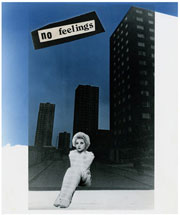December 03, 2007
Re-entering the Twentieth Century
(Here's some text I provided for the recent Jamie Reid exhibition at Croydon H E College).

Leave the twentieth century? We have to get back there first. Stranded here, at the end of History, in the drear grip of the post-1989 Restoration (of family values, economism), the 20th century seems impossibly modern.
Many of Jamie Reid’s most important images are presided over by the ambivalent figure of the tower block. The official judgement promulgated at the end of History is that the tower block was an abomination, the relic of a degenerate and unworkable project to engineer a new kind of public space. Look at Reid’s work from the 1960s and 1970s now and you are taken back to the struggle over urban planning that was at the heart of the 20th century. Would the city be the execution of a Radiant masterplan or the site of a permanent dérive? In either case, the city was envisaged as a the habitat for a new kind of human. In the 21st century, such humans can no longer be imagined. Only ‘nice families’ living in ‘nice houses’ are welcome here. Centralised planning has been replaced by a control apparatus whose implacable despotism cloaks itself with the appearance of public consultation and consumer preference. But did anyone ask you whether you wanted London to be gradually, greedily consumed by the 2012 SF Capital Megatastrophe?

The tower block was a precondition for punk, and it was only in its more conservative moments that punk lapsed into a humanist protest against the alienating effects of brutalist architecture. Punk was far more interesting when it could be heard as a cry of exuberant alienation which rejected beaches in favour of pavement, which preferred concrete to a ‘Nature’ it derisively exposed as a reification.
Capitalist realism – the idea that capitalism is the inevitable terminus awaiting all societies fortunate enough to reach the End of History – relies on a naturalization of current social conditions, a naturalization that photoshops out politics and replaces it with TV parliamentarianism. The significance of Jamie Reid’s work was always to estrange the environment presented to us as natural by advertising. All culture in the 21st century tends to the condition of advertising. More than ever, we live inside adverts and adverts are inside us. The environments we move through are walk-through, interpassive simulations, and we are the carriers of a pulsing videodrome signal that has colonized our unconscious, secreting its banal aspirations into our electric dreams. Specific adverts sell products, but the form of advertising sells Capital itself. Nothing else is on offer.
Reid’s work reminds us of a time when it seemed possible to step outside the banalizing boulevards of advertising, to a time, that is to say, when the strategy of detournement had not itself been incorporated into the massive recuperation that is postmodernism, the cultural logical of late capitalism. Late capitalism’s wrap-around, seamless, CGI-enhanced semiotic terrain is so totally pervasive that it makes the idea of a Spectacle seem quaint. Where is the new Jamie Reid who can rouse us from our Restoration stupor, where is the cyberpunk that can blast a hole in the naturalised Graphic-User Interface of late capital’s mega-Matrix?
Posted by mark at December 3, 2007 02:54 PM | TrackBack